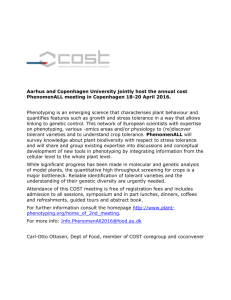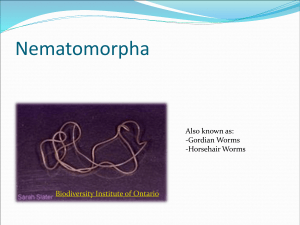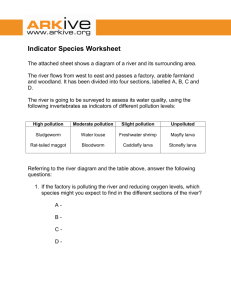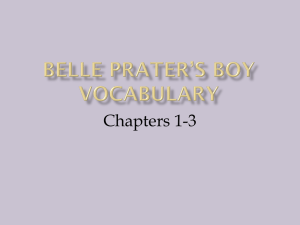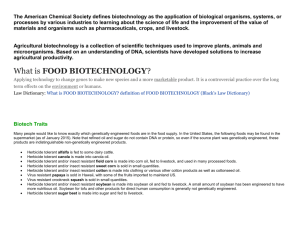Macroinvertebrate Table - Valley Catholic School
advertisement
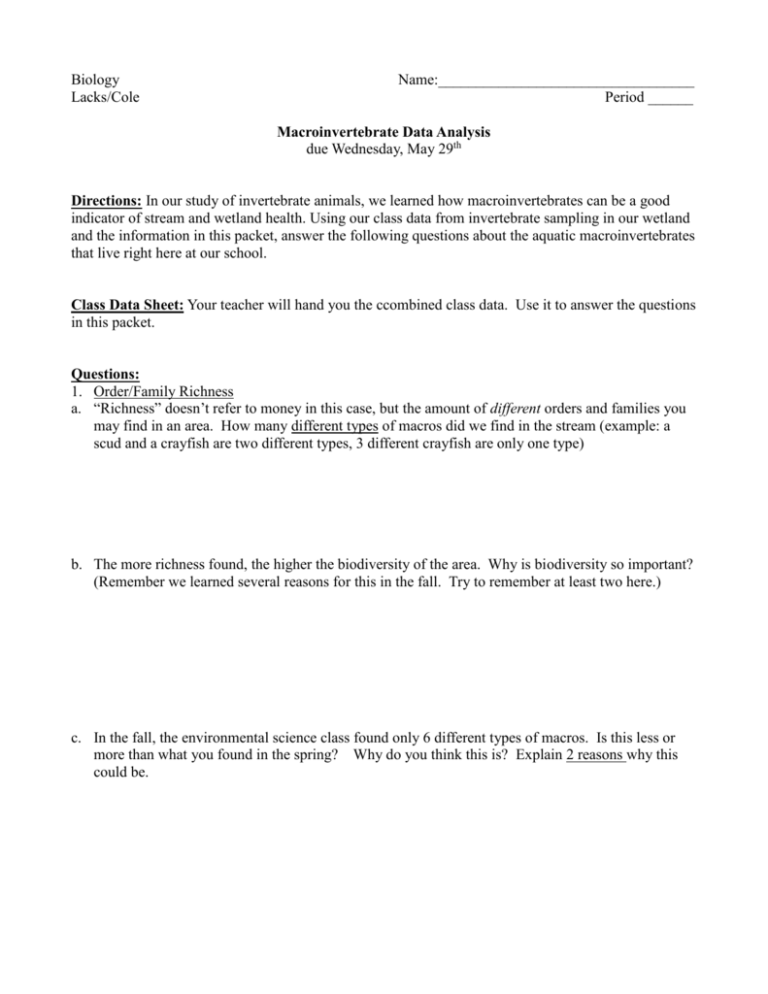
Biology Lacks/Cole Name:__________________________________ Period ______ Macroinvertebrate Data Analysis due Wednesday, May 29th Directions: In our study of invertebrate animals, we learned how macroinvertebrates can be a good indicator of stream and wetland health. Using our class data from invertebrate sampling in our wetland and the information in this packet, answer the following questions about the aquatic macroinvertebrates that live right here at our school. Class Data Sheet: Your teacher will hand you the ccombined class data. Use it to answer the questions in this packet. Questions: 1. Order/Family Richness a. “Richness” doesn’t refer to money in this case, but the amount of different orders and families you may find in an area. How many different types of macros did we find in the stream (example: a scud and a crayfish are two different types, 3 different crayfish are only one type) b. The more richness found, the higher the biodiversity of the area. Why is biodiversity so important? (Remember we learned several reasons for this in the fall. Try to remember at least two here.) c. In the fall, the environmental science class found only 6 different types of macros. Is this less or more than what you found in the spring? Why do you think this is? Explain 2 reasons why this could be. d. The Clackamas River is a fast-moving river on the east side of Portland that originates from Mt. hood snowmelt. The richness that is usually found in that river and its tributaries, using similar methods to ours, is 15-20. Our wetland feeds into the Tualatin River on the west side of Portland. What was the difference between the findings in these two areas (if any)? Why do you think this is? Explain 2 reasons why this could be. e. What do you think our richness data says about the health of our wetland? 2. Pollution Tolerance: a. Using the Macroinvertebrate Table at the end of this packet, figure out how many individuals our class found in each of the categories below. Pollution Tolerance Number of individuals Pollution Intolerant (can't live in polluted water) Pollution Sensitive (can live with a little bit of pollution) Pollution Tolerant (can live with a fair amount of pollutiondoes NOT mean that it prefers pollution) b. Did we find the most macros in the Pollution Intolerant, Sensitive, or Tolerant group? c. What do you think our findings say about the health of our wetland? (Think about the combination of individuals from the different categories.) 3. Life Span: a. Using the Macroinvertebrate Table at the end of this packet, figure out how many individuals our class found in each of the categories below. Life Span Number of individuals Long (1 year or more) Medium (more than 1 month, up to 1 year) Short (1 day- 1 month) b. Did we find the most macros in the long, medium, or short lifespan? c. What do you think our findings say about the health of our wetland? Really think about his one!!!! 4. Feeding Habits a. Using the Macroinvertebrate Table at the end of this document, figure out how many individuals we found in each of the categories below. Feeding Habit Predator – feed on other invertebrates (e.g., dragonflies) Omnivore – generalist feeders able to feed on both dead and living organic matter (e.g., crayfish) Collector/Filterer – consume fine pieces of organic matter like leaf fragments suspended in the water (e.g., mussels). Scraper/Grazer – feed on attached plants and algae located on submerged underwater surfaces (e.g., snails) Shredder – consume coarse organic matter such as leaves (e.g., sowbugs) Piercer – feed by piercing the tissues of other organisms (true bugs - hemiptera) Number of individuals b. In which feeding group did we find the most macros? c. Was there a large or small variety of feeding habits? d. What do you think our findings on feeding habits say about the health of our wetland? (Think about what we learned about ecosystems and communities back at the beginning of the year.) Taxonomic Groups: -How many organisms in the Phylum Mollusca did we find? -How many organisms in the Phylum Arthropoda did we find? Macroinvertebrate Table Macro Name Pollution Sensitivity Life Span (in water) Feeding Habit Alderfly Larva Aquatic Sowbug or Isopod Intolerant Tolerant 1-3 years 1-2 years Predator Shredder Backswimmer Black Fly larva Bristle Worm Caddisfly Larva Copepod Tolerant Tolerant Tolerant Sensitive Sensitive 1-2 years 3 weeks 1-2 years 2-7 months 1 month – 6 months Crane Fly Larva Crawling Water Beetle Sensitive Tolerant 3 days 1-2 years Collector/filterer Scraper/grazer Crayfish Damselfly Larva Diving beetle Larva Dobsonfly Larva Dragonfly Larva Fishing Spider Flatworm or Planaria Sensitive Tolerant 2-3 years 1-2 years Omnivore Predator Intolerant Tolerant Tolerant Intolerant 1-3 years 1-3 years 1-2 years 1-3 years Predator Predator Piercer Omnivore Tolerant 3-10 years Collector/filterer Tolerant Tolerant Tolerant Tolerant Tolerant Tolerant Tolerant Sensitive Tolerant 1-2 years 3-5 years 1-3 years 3-6 years 2-10 years 3-10 years 1-2 years 2-4 months 3 days Piercer Scraper/grazer Predator Predator Piercer Collector/filterer Piercer Scraper/grazer Scraper/grazer Tolerant Tolerant Tolerant 3-5 years 3-10 years 3-5 years Scraper/grazer Collector/filterer Scraper/grazer Freshwater Mussel Giant Water Bug Gilled Snail Horse Fly Larva Horsehair Worm Leech Limpet Marsh Treader Mayfly Larva Midge Larva or Pupa Orb Snail Pill Clam Pouch Snail Piercer Collector/filterer Omnivore Scraper/grazer Collector/filterer Predaceous Diving Beetle Larva Predaceous Diving Beetle Sensitive 1-3 years Predator Intolerant 1-2 years Predator Pyralid Caterpillar Rat Tailed Maggot Larvae Tolerant Tolerant 2-3 years 1 to 2 years Scraper/grazer Collector/filterer Riffle Beetle Riffle Beetle Larva Scud or Amphipod Stonefly Larva Tubifex Worm Water boatman Water Mite Water penny Water Scavenger Beetle Intolerant Sensitive 1-5 years 1-2 years Scraper/grazer Scraper/grazer Sensitive Omnivore Intolerant Tolerant Tolerant Sensitive Intolerant Tolerant 6 months- 1 year 1-3 years 3-5 years 1-2 years 1 month 1-2 years 1-2 years Omnivore Collector/filterer Piercer Predator Scraper/grazer Omnivore Water Scorpion “nepa” Tolerant 1-2 years Piercer Water Scorpion “ranatra” Tolerant 1-2 years Piercer Water Snipe Fly Larva Intolerant 10-11 months Predator Water Strider Whirligig beetle Tolerant Sensitive 1-2 years 1-2 years Piercer Predator Resources used in making the above table: http://tolweb.org/Trichoptera/8230 http://www.weloveteaching.com/hopepond/macrobug/macrobug.htm http://www.epa.gov/bioiweb1/html/benthosclean.html http://bugguide.net/node/view/63/bgpage


